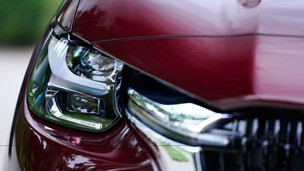Stuck with an old banger that’s gathering dust in the driveway because it’s so bad? Or maybe you bought a new car, but you’re just not satisfied with the way it drives?
Before you throw in the towel and make the swap to a new vehicle, there are a couple of handy tips if you want to transform your car from a hunk of junk into something a little (or a lot) more lively.
Most of these are easy enough fixes that you can do in your own garage if you have a decent set of tools and some general know-how. Be warned, though, that if you’re ever unsure about working on your car, it’s always best to take it to a professional.
Likewise, some of these modifications may have the potential to void your warranty, so it’s always best to check with your warranty company or the dealership you bought your car from in advance, just to make sure.
1. Polyurethane steering rack bushings

Most modern cars come with rack and pinion steering, which means that the steering wheel is directly connected to a rack that uses either hydraulic fluid or electric motors to help the wheels move.
This steering rack is fixed to the body with rubber bushings, but these are prone to flexing and deterioration over time. Replacing them with two-piece polyurethane bushings will instantly make your steering input more direct thanks to less flex in the system, resulting in a feel that’s a lot more sporty and a lot more precise.
You can pick a set up for as little as £20 online, so it’s a no-brainer for the cash-strapped performance hound. You can also swap all your suspension bushings for polyurethane, but if you’re looking for an instant upgrade, the steering rack should be top of the list.
2. High-quality brake pads

What’s the most important component when you want your car to go fast? An aero kit? Huge engine? Super-slick tyres, maybe?
Actually, it’s the brakes. It might seem a little counter-intuitive, but investing in a set of high-quality brake pads is one of the best and cheapest modifications you can make to upgrade your car. After all, presumably you’ll want to slow down after you’ve had enough of going fast.
You don’t have to splash your cash on a full race-specific brake setup, either, as something as simple as the pads themselves can reduce stopping distances and go a long way to eliminate fade in hard braking situations.
Anybody who’s even moderately mechanically inclined can replace the pads in an hour or so, so it makes sense to save a few bucks if you can. If you’re not sure, though, as always, take it to an expert.
3. Throttle adjustment

Ask any serious driver and they’ll tell you that one of the most important benchmarks for whether a car is fun to drive or not is how quickly the engine responds to you putting your foot down on the accelerator.
Older cars, which use a throttle cable, come with a physical coupling between the pedal and the throttle body on the engine, and over time the cable can get stretched out and might need adjustment. On most cars with throttle cables, this can be solved simple with a wrench and five minutes of your time.
More modern vehicles are a bit more complex, with drive-by-wire throttles, where all accelerator functions are controlled by an electronic motor and a potentiometer on the pedal.
Luckily, you won’t have to get your hands just so dirty, as performing an accelerator relearn procedure to update the electronics is usually as simply as disconnecting your battery for a few minutes, and then hooking it back up.
Different cars do tend to vary in their throttle remapping procedures, though, so it’s always best to consult the car’s manual first, or a professional. It’s worth it though, as a properly adjusted throttle can have a night-and-day effect on your car’s performance and driveability.
4. Front strut tower bar

One of the few modifications that the Fast and the Furious got right was the front strut tower bar. Not just another place to put a sponsor advertisement, it does actually have a very functional purpose.
You might have seen them before and wondered what they were for; a front strut tower bar sits in the engine bay of your car (or where the storage area is, if you have a mid- or rear-engined car), and helps reinforce the chassis.
Essentially connecting the car’s strut towers on either side together so that they don’t flex independently, the strut tower bar helps to produce handling that’s more predictable and direct, giving drivers more confidence and cornering ability.
Name-brand bars can be on the expensive side, though you can pick up cheap aluminium ones on eBay or on other parts sites that will do the job just as well as any welded/carbon fibre concoction.
5. Boost controller

More of an enthusiast one this, but if you have a car with a turbocharger, you’ll no doubt know the thrill of mashing in the accelerator and listening to the air go PPSSSWHEEEUWWWW into the engine cylinders.
If you want to give your car an even harder boot up the behind, you can fit a little valve between the turbo’s compressor, which makes the boost, and the wastegate, which makes sure you don’t have too much boost.
Older cars can use this homemade remedy to trick the wastegate into thinking it’s getting less boost than it is, while you can also buy a ready-made boost controller component which does the same job.
Be extremely careful though, as only small increases in boost will be tolerated by your car’s fuel system and ECU. Anything more and you risk having to custom tune all your fuel maps to ensure you don’t blow the whole thing up. Caution definitely advised.
6. Manual gearbox fluid upgrade

Many drivers don’t realise that a manual gearbox requires fluid in it in order to work. Automatic transmissions can, in theory, run without it, but a manual with no fluid left in it will grind itself to a metallic death pretty quickly.
If you want to keep your gearbox slick and smooth for as long as possible, it’s important to have the right fluid that can withstand the stresses of spirited motoring. It’s best to consult your manual for what fluid is best to use, but the difference will be immediately noticeable once you get it changed.
Virtually eliminating any of that horrible notchy feeling that’s typical of gearboxes running low on fluid, it’ll also protect your car when it’s warming up in the cold and is better suited to protecting the gears and synchros when everything’s heated up nicely.
A bottle of new fluid will set you back about a tenner, while to change it it’s as easy as jacking your car up, unscrewing a couple of caps and replacing the fluid before screwing it back up and motoring off!
7. Weight distribution

If you’ve ever driven an MX-5 or a BMW, you’ll know all about the benefits of weight distribution. Essentially, cars that have an equal amount of weight over the front and rear wheels handle better than those that have a front or rear weight bias.
If your car has a significant bias, there are a couple of things you can do about it. Be warned though, most of these are pretty intrusive, and are therefore best only for enthusiasts or for drivers looking to do up an old banger.
Relocating your battery from the engine bay to the boot, removing your rear seats and all other non-essential items like carpets, the radio and speakers can go a long way to light-weighting your car and making it nimbler and quicker.
It might be a bit louder, a bit less comfortable and a bit hotter than you’d like, but if you’re serious about performance, just crack a window and smash the gas pedal.
8. General maintenance

Forget expensive modifications or long hours spent wrenching in your garage, one of the best methods for helping your car run in tip-top condition is simply by taking good all-round care of it.
Fluid flushes, spark plug changes and fuel filter upkeep will all keep it in good nick, as will using the right quality fuel and changing the belts regularly. A lot of drivers don’t pay close attention to the maintenance schedule, but if you keep a good eye on it, your car can last years beyond its lifespan.
After all, a poorly-kept car might cost you a lot in the long run, but simply being aware of when to get it seen to can be the difference between a track star and a barely-running hunk of junk.



